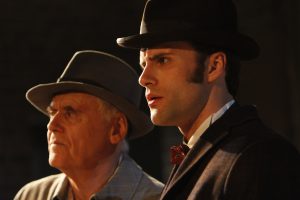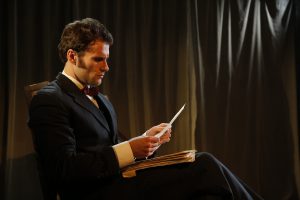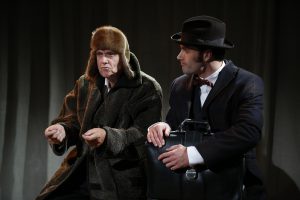
Just imagine Merry Old England during Queen Victoria’s reign. A thick yellow-green fog, also called pea-soup, wafting over London, Jack the Ripper slashing young women in Whitehall and Oscar Wilde, the once pampered enfant terrible of Britain’s upper crust, being sent to prison because of his homosexuality, a deadly sin at that time. A fantastic period for writers who like tales about ghosts and “the living dead” inhabiting old castles and run down manors in remote regions.
Susan Hill’s book “The Woman in Black” can be called a genuine Victorian novel. It is a Gothic thriller at its best, set in an empty Victorian theatre in London during the late 19th century. It was constructed as a play within a play and involves two gentlemen, a young nameless actor and a middle-aged solicitor named Arthur Kipps. Both are acting on a nearly bare stage. What at first sight seems to be a rehearsal of a sinister play turns out to be kind of a confession by Kipps who experienced a shocking family drama some thirty years ago. In writing down his memories, he tries to get rid of a nightmare involving a mysterious Woman in Black with a pale wasted face who has been haunting him ever since.

As the play evolves, we go back to Arthur Kipps’ former existence as a young solicitor who is called to a remote place in England in order to settle the affairs of his recently deceased client Mrs. Alice Drablow. While staying in a small village he experiences a disturbing encounter with a spectre which has a major impact on his life. Deeply shocked by this eerie apparition, he asks the villagers about that Woman in Black. But all turn away from him and deny in a hostile manner the mere existence of such a woman. Meanwhile mysterious accidents happen to small children wherever a woman totally clad in black turns up. A terrible accident occurs to Kipps’ beloved wife Stella and their young son Joseph while riding on a pony and trap. The child is hurled from the trap against a tree and dies on the spot while Stella succumbs to her injuries a couple of months later. Eventually the Woman in Black has also taken revenge on his family. What is the reason for her hatred? Arthur is in deep grief and wants to find out the motives that drive the black apparition to kill innocent children and make their parents suffer. While in Mrs. Drablow’s dark uncanny old house, he reads all the papers on her desk and finally comes across a packet of letters that were written sixty years ago. The correspondence between Mrs. Drablow and Jennet Humfrye, a young unmarried woman, opens his eyes and makes him shiver with fear. When Jennet got pregnant, her family sent her away to Scotland. Right after she had given birth to a boy, the baby was taken away from her and given free for adoption. Mrs. Drablow, Jennet’s elder sister, adopted the boy and let Jennet see him from time to time. When she tried to run away with her boy, he died in an accident on the marsh. Jennet never got over his death and planned revenge on the heartless puritanical society that – as she saw it in her grief – was responsible for his death at such a young age. Shortly after her child passed away, she died herself of an incurable disease and turned into the Woman in Black, the embodiment of Nemesis, the Greek Goddess of Revenge. From that very moment on she began haunting the countryside, and anybody who caught sight of her lost a child either in an accident or after an illness. The curse of an evil fairy came true.
The last scene brings us back to London. The rehearsals are over and Arthur Kipps thanks the young actor for helping him to make a play of his story about the Woman in Black. Mr. Kipps is taken aback when the young man asks him who the lady was who played the Woman in Black during their rehearsals. “But you and I were the only ones in the theatre”, he replies. The actor is bewildered. Whom, by God, did he see all the time on the stage – the real Woman in Black?

Dear spectator, if you want to understand every detail of this complex plot, you have to concentrate on every word spoken. Be very attentive when “jumping” from London to the haunted house in the far-away village and back to the theatre. And don’t forget, only two actors are on the stage, changing from one role into the next. While Angus Villiers-Stuart “only” has to play the Actor and the young Arthur Kipps, Séamus Newham as the middle-aged solicitor has to cope with at least three other parts. He changes coats, hats and accents at a breath-taking speed. Many thanks to both of you as well as to director Paul Glaser for a grand performance and an unforgettable evening. Standing ovation for two outstanding actors and the whole staff involved in the realisation of the play. It would be unfair not to mention the Woman in Black – so to speak the main character of the play – who was present all the time without pronouncing a single word. Thank you too, Barbara Goodman, for making the blood running cold in our veins by your totally mute presence.
It was indeed daring to make a play of Susan Hill’s Victorian thriller, the more so as the Hollywood movie starring Daniel Radcliffe proved to be an overwhelming success. Forget about the film when you are sitting in The English Theatre since the adaption of the novel by British playwright Stephen Mallatratt is absolutely brilliant. As a matter of fact, the technical means of a theatre are quite limited compared to the state of the art technology used by the film industry. In “The Woman in Black” the TET is working with uncanny noises – sobbing and wailing of an infant, screams of a distressed woman, thunder and lightning in front of the house and the clatter of hooves – thus achieving disturbing thrilling effects. The Woman in Black is a deeply unsettling and scary horror tale that sometimes comes near to Mary Shelley’s Frankenstein novel. Indeed, a spine chilling ghost story.
(Photos: Stefan Kock)
Final performance of “The Woman in Black” on November 2, 2019
Tickets under phone number 040 – 227 80 89 , online booking under www.englishtheatre.de
Next premiere: “Funny Business”, a farce by Derek Benfield, on November 14, 019
